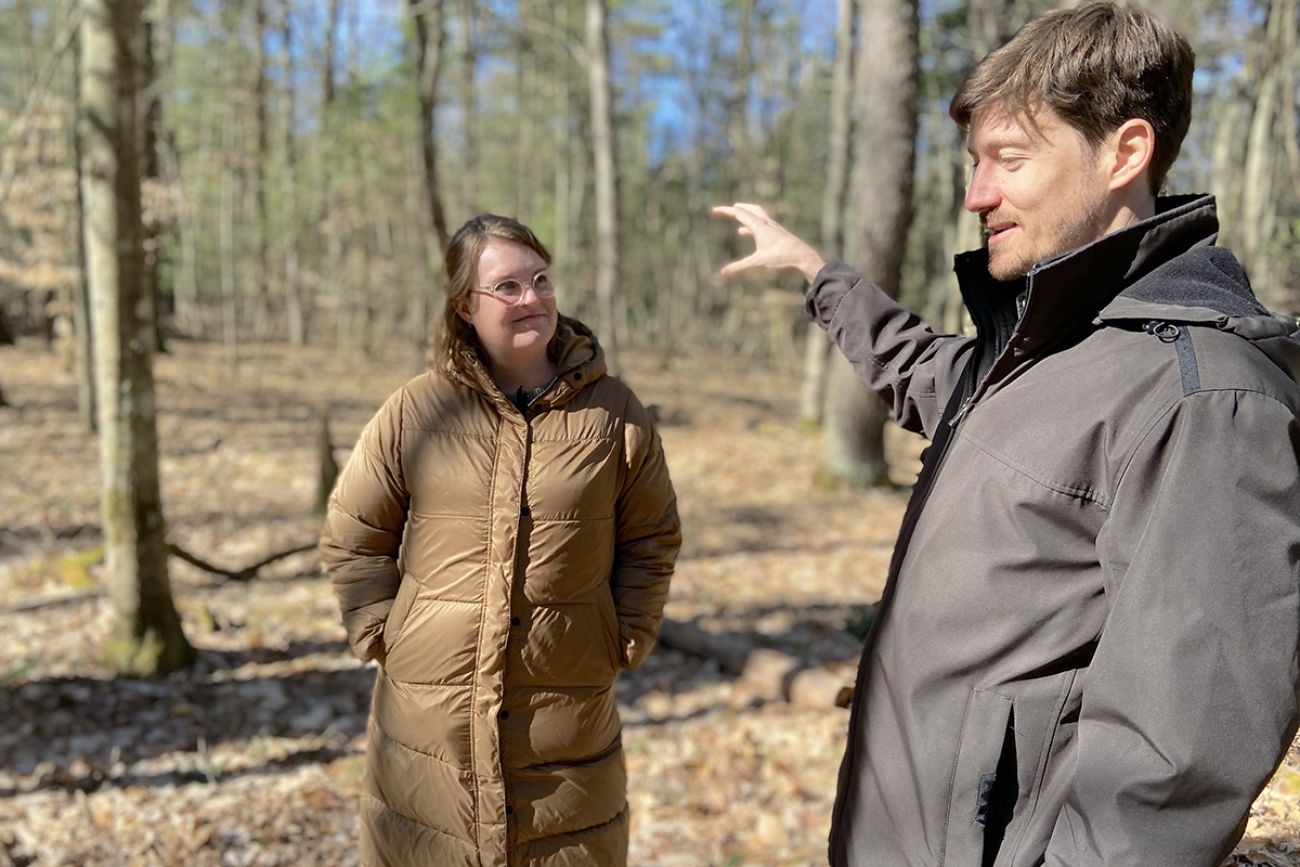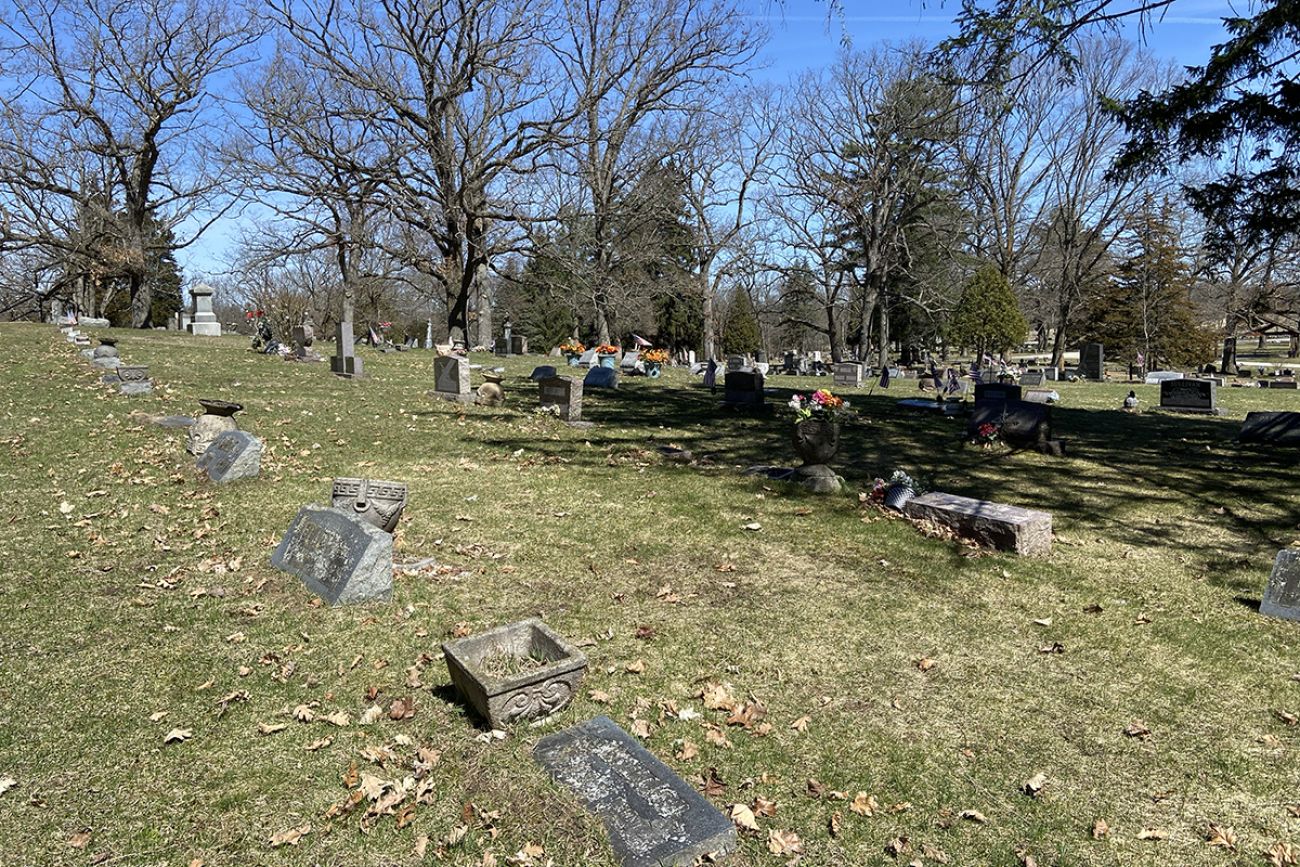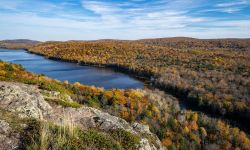‘Green burials’ catch on in Michigan. Cemetery controversy follows

- Green burial, or burying the dead without toxic embalming chemicals or non-biodegradable materials, is growing more popular
- There are now at least 16 Michigan cemeteries offering green burial, with more in the works
- The industry’s expansion is sparking debate in some Michigan communities, as local governments decide how (and whether) to make way for an unfamiliar practice
NEWAYGO — On 20 forested acres near the Manistee National Forest, Peter and Annica Quakenbush thought they had found the perfect spot to offer a new option for Michiganders’ final rite of passage.
The Grand Rapids couple are among a growing number of Americans interested in “green burial” practices that eschew metal caskets, toxic embalming chemicals and concrete vaults in favor of simple burials involving only biodegradable materials.
They hoped to perform modest burials beneath the trees in Brooks Township, just outside Newaygo, with headstones made of locally-sourced rocks. The land would be crisscrossed by walking trails and permanently protected from development.
“It came from an impassioned (sense that) there needs to be a major cultural shift in how death works, and how we deal with the dead,” Annica Quakenbush said.
But as the pair would soon find out, not everyone shares that view.
The death-industry alternative has sparked debate in Michigan, where some communities have embraced it while others have rejected it. At least one state, Minnesota, has temporarily banned new cemeteries that offer the practice.
As word got out about the Quakenbushes’ plan to create the West Michigan Burial Forest, neighbors complained to local public officials, citing fears of water contamination from decomposing bodies and traffic from funeral processions along their dirt road.
Local officials responded by banning all cemeteries in Brooks Township, following the advice of a township attorney who raised concerns about “the uncertainty involved” in the couple’s plan to open a private cemetery with unfamiliar practices.
“There’s just very little precedent here,” attorney Cliff Bloom told the township zoning board in February.
Hundreds of miles away in Michigan’s northernmost reaches, meanwhile, small-town governments are embracing the notion of green burial, reaping financial benefits in turn.
“I like to tell people that this isn’t new,” said Craig Austin, cemetery sexton for Chassell Township, an Upper Peninsula community that has been allowing green burials in its local cemetery for several years. “Back in the 1800s and early 1900s, this is exactly what they were doing.”
The opposing responses reflect the tension points as Michigan becomes a nascent hub for green burial, and local governments consider whether to welcome the practice.
Last year, 60% of people surveyed by the National Funeral Directors Association expressed an interest in green burial. But with little state or federal guidance on how to regulate cemeteries that offer the practice, communities are approaching the issue piecemeal, and often in vastly different ways.

A not-so-new era in death
The Quakenbushes’ plans in west Michigan fit into a nationwide shift in the way Americans die.
For decades, conventional embalmed burial had been waning in popularity as more people turned to cremation. In recent years, green burial has increasingly been part of the mix.
Related:
- Green burials, ash jewelry are a thing now in Michigan. Can state law adjust?
- Flush with cash, Michigan lawmakers try again to pass state septic code
- After 18 years, Dems aim to restore Michigan pollution regulators' power
There are now more than 440 cemeteries offering the option in the U.S. and Canada, at least 16 of them in Michigan.
Supporters favor green burial for its lower environmental impact and cost. Eschewing embalming, fancy caskets and vaults can save thousands of dollars, while avoiding the harmful chemicals involved in embalming and the greenhouse gasses emitted during cremation and cement-making, said Lee Webster, a green burial advocate who co-founded the Conservation Burial Alliance.
“People are beginning to recognize that funerals have a huge price tag, both environmentally and money-wise,” Webster said. “They’re looking to try to reduce their carbon footprint in their final exit.”
The practice of allowing bodies to naturally decompose is not entirely new. Before the Civil War led to advances in embalming, it was the norm in America. And it has remained a common Hebrew, Muslim and Amish tradition.
At a minimum, the practice eschews embalming and non-biodegradable containers, instead favoring fabric shrouds and wicker or wood caskets. Headstones are often modest or nonexistent, and burial grounds sometimes look more like a field or forest than a manicured cemetery lawn.
Michigan’s laws are generally green-burial friendly, which is helping drive interest in the practice, said Cindy Dodge, a liaison with the Michigan Townships Association who advises local governments on cemetery issues.
The law doesn’t require embalming or burial vaults and includes no requirements for grave depth (green burial typically involves shallower graves to aid in decomposition).
In fact, the law makes no distinction between conventional or green burial, and Michigan has no specific regulations governing green burial practices. Although professional organizations that certify green burial cemeteries have established their own standards, the spotty government regulations pose a problem for local officials, said Ronald M. Redick, a local government lawyer with the Grand Rapids firm Mika Meyers.
“Deciding whether it is or isn't safe, or what the appropriate conditions should be (for green burial), it ought not be done on a patchwork basis across thousands of municipalities,” Redick said.
A battle in west Michigan
The Quakenbushes bought the property in Brooks Township last year, hoping to establish a business or nonprofit that would be part burial site, part publicly-accessible nature preserve.
Health department inspectors visited the property and found no issues with siting a cemetery there.
But as neighbors began to express concerns about traffic, water quality and changes to the neighborhood, the township board took the unusual step of banning all cemeteries in the 3,700-person community.
Noting that cemeteries can take up large quantities of land, and that the expense of maintaining monuments and landscaping sometimes fall to local governments when private cemeteries are abandoned, the board declared the ban “essential for the health, safety and welfare of Brooks Township property owners, residents and visitors.”
Bloom, the township attorney, didn’t respond to requests for comment from Bridge. Township Supervisor Cory Nelson declined to comment, citing the Quakenbushes’ lawsuit.
“I have a lot to say, but it will have to wait,” Nelson said.
The Quakenbushes call the township’s claims irrelevant, noting their plan calls for no landscaping or fancy grave markers. And like all private cemetery owners in Michigan, they would be required to establish a trust fund of at least $50,000 to cover long-term upkeep.
Arguing that the township’s true motivation is a fear of change, they’re suing with the help of the Institute for Justice, a libertarian-leaning nonprofit law firm known for taking property rights cases.
“The Michigan Constitution doesn’t allow a municipality to ban a safe land use just because it is unique or misunderstood,” said Katrin Marquez, a lawyer for the couple.
It’s not the first time a green burial proposal has been met with skepticism by neighbors and local officials. Last year, Minnesota lawmakers put a two-year moratorium on new green burial cemeteries after controversy erupted over a proposed cemetery near Duluth.
And tensions over a proposed green cemetery in Livingston County prompted local officials to seek extra environmental review before approving the plan.
But Redick, the local government attorney, said he’s not aware of any other example of a local government banning cemeteries altogether.
While the legal process drags on, public sentiment is divided between neighbors who oppose the burial forest, and those who say it would be an asset to the township.
The debate has sometimes been tinged with misinformation. At a recent public hearing, one man said he feared “20,000 dead people in my backyard.” The Quakenbushes say they plan to sell around 3,000 plots.
Other residents raised concerns about funeral traffic on the dirt road that leads up to the property, while one neighbor told Bridge Michigan it will take more than a health department inspection to alleviate his concerns about groundwater contamination from decomposing bodies.
“I don’t want to be drinking somebody’s rotting flesh,” said Larry Norburg, who lives next door. “And the so-called experts aren’t going to be living here, right next to it.”
Research into the water quality impacts of cemeteries appears to be limited. But Webster, the green burial advocate, noted that there have been no known water quality issues associated with the hundreds of green burial cemeteries already in operation.
Supporters of the burial forest argue it would offer residents a new service, and could bring in commerce from out-of-town families who would hire local funeral directors and spend money visiting their loved-one’s grave.
But rather than considering the Quakenbushes’ proposal, said Sally Wagoner, board chair of the Newaygo County Environmental Coalition, “the township chose to eliminate any possibility that they would have to deal with something that they don’t understand.”

Keweenaw finds success
Four-hundred-and-seventy miles north of Brooks Township, on the Keweenaw Peninsula, Chassell Township’s Austin said he also had reservations when a resident suggested allowing green burials in the township cemetery.
Austin’s decades of experience with conventional burials had made him wary of change.
“I just didn’t know much about it,” he said. “I was the old traditional, you know? This is the way burial should be.”
He feared that without a vault to give structure to graves, the soil would cave in. And he worried animals would dig up human remains, since green burials require shallower graves.
Those concerns turned out to be unfounded. The township has now been doing green burials for five years without issue, he said.
Embracing the practice has allowed Chassell Township to make use of a steep, wooded section of the cemetery that wasn’t suitable for conventional burials. And it has been a financial boon for the township. Plot purchases have increased nearly sevenfold, from about three annually to 20.
Now, Austin takes calls from cemetery officials in other Michigan towns who are looking to get into the green burial business. And when he’s out walking, residents sometimes stop him to ask about purchasing a plot.
Why did Chassell Township officials react so differently than their counterparts in Brooks Township?
For one, Austin said, the Keweenaw already had a strong community of green burial advocates, who helped local officials navigate the process of crafting strong rules to regulate green burials.
But perhaps more importantly, he said, Chassell Township’s cemetery already existed. That reduced the likelihood of pushback from residents worried about a changing neighborhood.
“All those houses were built with the cemetery already being there,” he said.

What’s next
Whatever happens in Brooks Township, the green burial industry is likely to keep growing.
Statistics from the National Funeral Directors Association show that interest in green burial continues to rise.
Dodge, of the Michigan Townships Association, said she advises local government leaders to embrace the practice, rather than fighting against it.
“You're really losing out on a service to your community when you don't offer green burials, because that's what people want,” she said.
Green burials have been so popular in the U.P.’s Chassell Township, the cemetery plots designated for them have almost sold out. Austin is pondering an expansion.
But down state in Brooks Township, the Quakenbushes’ lawsuit may force a judge to decide whether the local government’s cemetery ban runs afoul of the Michigan Zoning Enabling Act, said Redick, the Grand Rapids lawyer. The act doesn’t allow local governments to ban land use types that are legal and meet a demonstrated need in the community.
The couple is prepared for a legal fight, said Peter Quakenbush. And if they lose?
“We’d have to sell it, pack our bags and move somewhere that is more accepting.”
Michigan Environment Watch
Michigan Environment Watch examines how public policy, industry, and other factors interact with the state’s trove of natural resources.
- See full coverage
- Subscribe
- Share tips and questions with Bridge environment reporter Kelly House
Michigan Environment Watch is made possible by generous financial support from:
Our generous Environment Watch underwriters encourage Bridge Michigan readers to also support civic journalism by becoming Bridge members. Please consider joining today.
See what new members are saying about why they donated to Bridge Michigan:
- “In order for this information to be accurate and unbiased it must be underwritten by its readers, not by special interests.” - Larry S.
- “Not many other media sources report on the topics Bridge does.” - Susan B.
- “Your journalism is outstanding and rare these days.” - Mark S.
If you want to ensure the future of nonpartisan, nonprofit Michigan journalism, please become a member today. You, too, will be asked why you donated and maybe we'll feature your quote next time!






